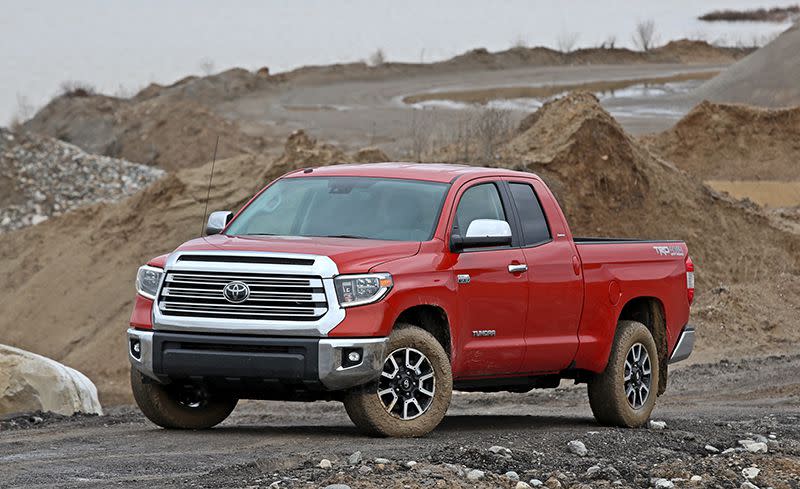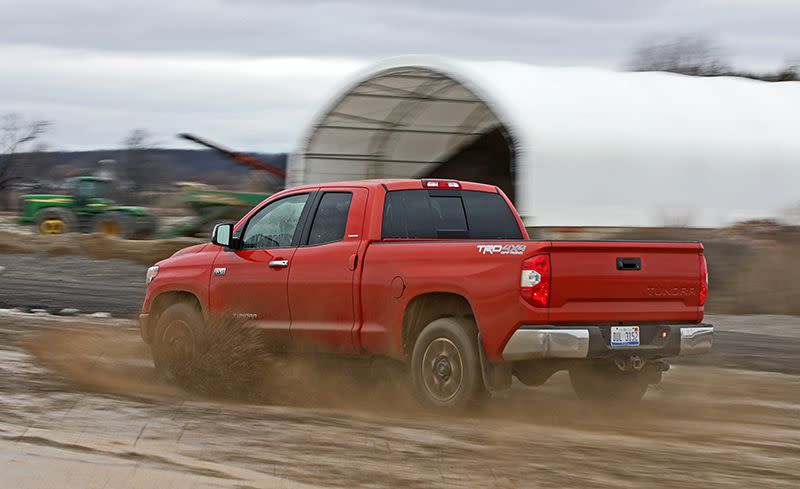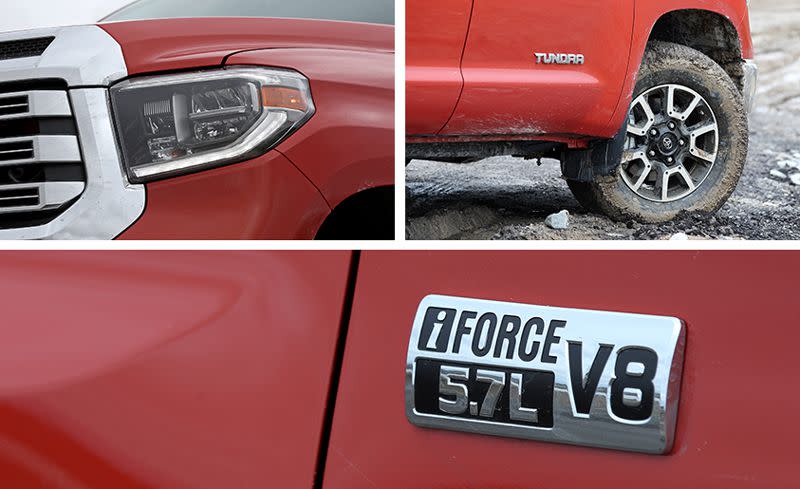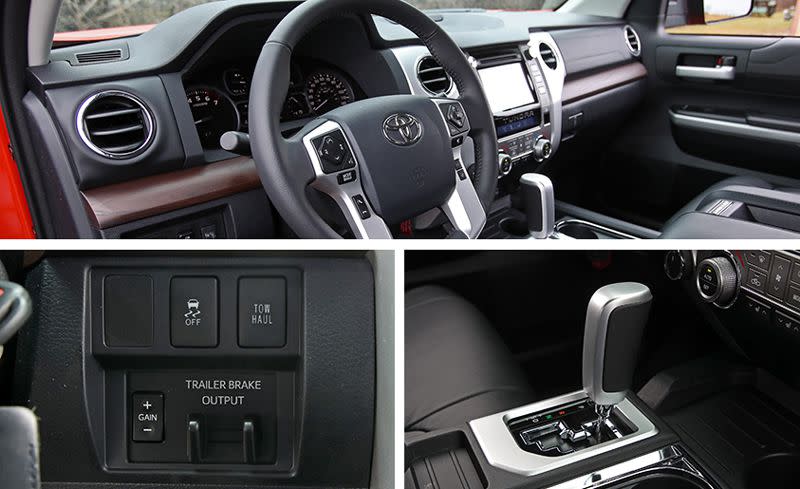2018 Toyota Tundra 5.7L 4x4 Double Cab: Time for a Change
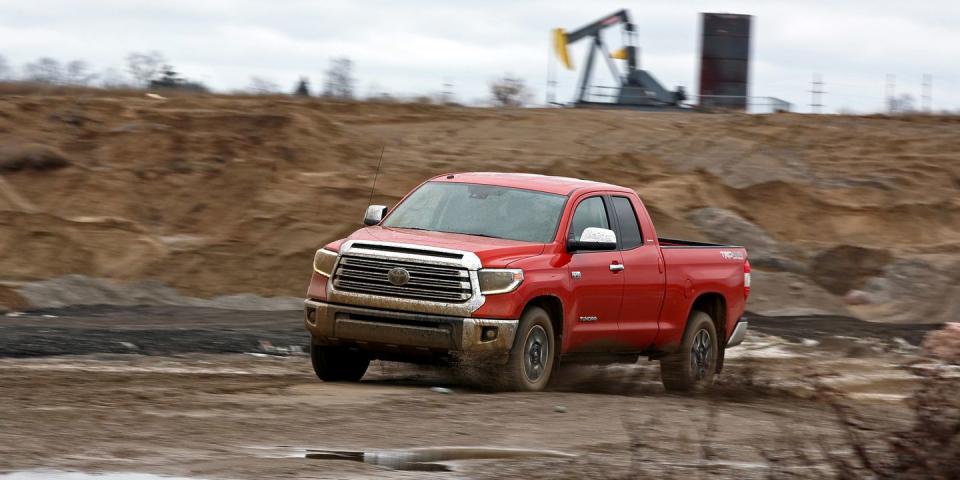
What It Is: The current-generation Toyota Tundra is an aging truck that faces off against a much fresher Ford F-150, with brand-new versions of the Chevrolet Silverado, GMC Sierra, and Ram 1500 on tap for 2019. The Tundra and the Nissan Titan are the only regular-duty full-size pickups to rely solely on V-8 powertrains. Although there certainly are truck folk who believe that’s the way it should be, the market has embraced more efficient options including turbocharged V-6s and turbo-diesels. The lack of powertrain choices and the dismal fuel economy from the V-8s are just two of the many things that dramatically date this pickup, which has been a good performer but even when new never seriously challenged the class leaders. Plus, aside from a few updates here and there, the 2018 Tundra is essentially the same truck that debuted for 2007.
For even deeper coverage of the Tundra, view our Buyer’s Guide in-depth review.
Why We Tested It and How It Performed: The Tundra comes in five different trim levels: SR, SR5, Limited, Platinum, and the 1794 Edition. For 2018, Toyota dropped the regular cab and TRD Pro models from the lineup, but did add an optional TRD Sport package for the SR5 trim. (The TRD Pro returns for the 2019 model year.) The 2018 Tundra is offered in Double Cab and larger CrewMax configurations, and customers have the choice of a 5.6-foot, 6.5-foot, or 8.1-foot cargo bed. V-8 engines displacing either 4.6 or 5.7 liters send their output to the rear wheels or all four via a six-speed automatic transmission. The 5.7-liter engine is optional on the SR and SR5 and standard on upper trims.
We hadn’t tested a Tundra Double Cab since the assembled-in-Texas pickup underwent a refresh for 2014. This particular example was a Limited-trim 4x4 Double Cab with the 6.5-foot bed and the TRD Off-Road package. The latter only costs an extra $70 on the Limited and includes model-specific five-spoke wheels, Bilstein off-road shocks, skid plates for the engine and fuel tank, front tow hooks, LED headlights and foglights, TRD floor mats, and TRD body decals.
Riding on 18-inch wheels wrapped in Michelin LTX AT2 all-terrain tires, this Tundra’s performance figures were very close to those of previous 5.7-liter trucks we’ve tested. Almost every acceleration test was within a few tenths, and braking and skidpad numbers were nearly identical as well, with a 190-foot stop from 70 mph and 0.70 g of grip.
What We Like: Like drinking a Coca-Cola out of a real glass bottle or waiting a full week to see a new episode of a TV show, there’s something comforting and enjoyable about doing things the old way. There’s a familiarity factor to the Tundra that’s missing from some of its newer competitors: There’s no whistling from a turbocharger, no pushbutton ignition, no oddball shifter, no weird belt-buckles or tribal tattoos strewn about the cabin, no materials too nice to get dirty. It’s just you, a big engine, a spacious cab, and a cargo bed.
That naturally aspirated 5.7-liter V-8 makes for good pick-up in this pickup. In our testing, the Tundra rolled from zero to 60 mph in 6.5 seconds, which feels plenty quick for such a big machine, although it’s significantly slower than rivals such as the F-150 and the Silverado. And when spurs are put to this V-8, its exhaust burbles nicely.
A notable, although subjective, achievement for the Tundra is how well its exterior design has aged. The steel body might be a bit bulging and bloated, but some found it handsome in a jeans-and-white-T-shirt kind of way. Where competitors have busy lighting elements and attention-seeking grilles, the Tundra now appears simple and subtle in comparison.
What We Don’t Like: The interior follows the exterior’s lead in simplicity. Despite having plenty of buttons, the chunky design makes it feel suitably truck-ish. But it’s painfully obvious that it comes from a different era. The 7.0-inch infotainment screen looks hopelessly out-of-date and low-res, and some of the buttons look and feel as if they could have been taken from a $10 alarm clock. The fake wood is egregiously so, and there are plenty of hard surfaces broken up by only a few soft ones.
The Tundra’s ride is floaty and disconnected, and there’s plenty of body roll. The steering is slow, the turning radius is huge, and there’s little to no feedback coming through the steering wheel. These are normal truck attributes and don’t bother us much, although many more modern trucks feel more buttoned down and precise to drive and place on the road. This Toyota requires constant attention to keep it on its intended path, and it feels every bit of its size and more.
The Tundra was Toyota’s first foray into the full-size, half-ton truck arena. While it could qualify as a valiant effort, few vehicles would be competitive going this long without a hard reset. It’s surprising how popular the Tundra still is-116,285 were sold last year-given the strength of the competitors in the market. But that could also explain why Toyota has not been in a hurry to redesign it.
Verdict: The Tundra ticks the traditional pickup boxes, but it has fallen even further behind fresher competition.
You Might Also Like

 Yahoo Autos
Yahoo Autos 